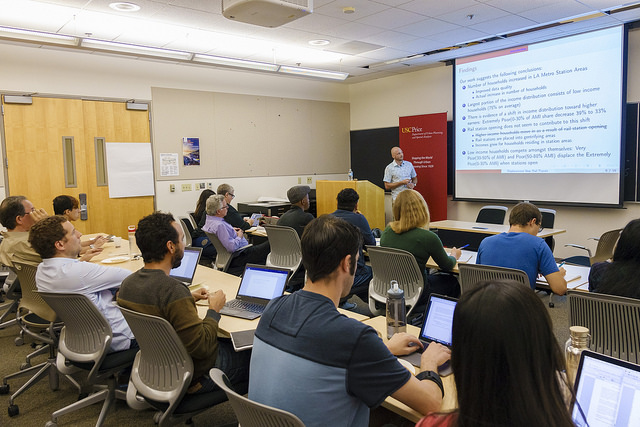News | Student Burinskiy Presents Findings on Gentrification Near Transit Stations
Stop the VideoNews

METRANS UTC
Student Burinskiy Presents Findings on Gentrification Near Transit Stations
Sunday, September 30, 2018
by By: Robin Franke, USC MPL 2019
On Monday, September 24th, the METRANS Speaker Series welcomed University of Southern California, Price School of Public Policy student Gene Burinskiy to discuss his doctoral research on “Gentrification Near Rail Transit Areas: A micro-data analysis of moves into and out of Los Angeles Metro rail station areas.” This highly relevant research brought a packed room for the event.
For his research, Burinskiy asked “Does rail transit development increase displacement of lower-income households?” He notes that many scholarly articles have been written about this issue but shares that his research is different because he uses micro-data, which is data that follows individual people and households rather than a large-scale analysis.

Photo taken by Deidre Flanagan, Communications Dept. Coordinator, USC Sol Price School of Public Policy
Burinskiy used data from the California Franchise Tax Board between 1993 and 2013 in areas within a half-mile radius of Los Angeles Metro Rail transit stations. Using this data, he computed the income distribution for each station and year from 1994 to 2012. He then computed the mobility of households entering and exiting the area and going out based on income distribution. This analysis gave him percentages of each income level likely to move into or out of the area both before the station opened and for multiple years after. In total, Burinskiy tested 44 LA Metro rail stations.
His findings revealed that there was an overall increase in households within the half-mile radius of rail stations, where over 75% of the households were considered low-income. There was also a decrease in the amount of extremely low-income households in the areas. Burinskiy noted that this change may have occurred due to the fact that the stations are located in areas that are already experiencing gentrification and also that over time resident incomes had increased overall.
In addition, the common belief that gentrification leads to high-income households pushing out lower-income households was not in sync with the results of the research. Instead, Burinskiy found that the proximity of rail stations had little impact on the movement of high-income residents. Interestingly, he found that the low-income households were actually competing with themselves. With the new rail station openings, low-income and very low-income households were less likely to move out which made it hard for the extremely low-income households to move into these areas.
While his research is still a work in progress, Burinskiy has made some intriguing insights on gentrification near rail stations with his unique micro-data method. He shared that his next step is to look at the effects near stations on a year-by-year basis instead of a cumulative change.
About the Author:
Robin Franke received her Bachelor of Science in GeoDesign from USC in 2018 and is now pursuing a Master of Urban Planning with a transportation emphasis. She is interested in transportation planning and urban design.
News Archive
- December (1)
- November (6)
- October (4)
- September (2)
- August (3)
- July (4)
- June (3)
- May (7)
- April (8)
- March (11)
- February (8)
- January (7)
- December (7)
- November (8)
- October (11)
- September (11)
- August (4)
- July (10)
- June (9)
- May (2)
- April (12)
- March (8)
- February (7)
- January (11)
- December (11)
- November (5)
- October (16)
- September (7)
- August (5)
- July (13)
- June (5)
- May (5)
- April (7)
- March (5)
- February (3)
- January (4)
- December (4)
- November (5)
- October (5)
- September (4)
- August (4)
- July (6)
- June (8)
- May (4)
- April (6)
- March (6)
- February (7)
- January (7)
- December (8)
- November (8)
- October (8)
- September (15)
- August (5)
- July (6)
- June (7)
- May (5)
- April (8)
- March (7)
- February (10)
- January (12)















